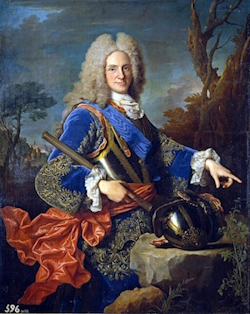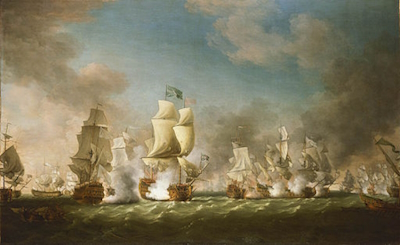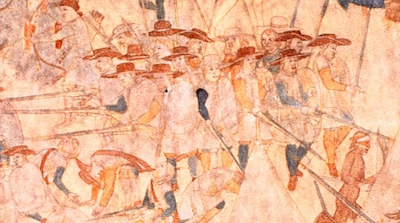 Although a Bourbon king, Philip V, took the throne of Spain after the War of Spanish Succession came to an end, Spain had been forced to give up territory in Italy and the Spanish Netherlands under the 1713 Peace of Utrecht. In 1718, the Spanish wanted to recover some of that lost land. As a result, the conflict known as the War of the Quadruple Alliance broke out between Spain and a coalition consisting of Great Britain, France, and Savoy, later joined by Austria after they had signed peace with the Ottomans. The Dutch Republic also joined the coalition in 1719. The war took place mainly in Sicily and northern Spain with some minor engagements in North America. Additionally, the Spanish supported Jacobite rising of 1719 in Scotland, which is considered to be a part of this conflict.
Although a Bourbon king, Philip V, took the throne of Spain after the War of Spanish Succession came to an end, Spain had been forced to give up territory in Italy and the Spanish Netherlands under the 1713 Peace of Utrecht. In 1718, the Spanish wanted to recover some of that lost land. As a result, the conflict known as the War of the Quadruple Alliance broke out between Spain and a coalition consisting of Great Britain, France, and Savoy, later joined by Austria after they had signed peace with the Ottomans. The Dutch Republic also joined the coalition in 1719. The war took place mainly in Sicily and northern Spain with some minor engagements in North America. Additionally, the Spanish supported Jacobite rising of 1719 in Scotland, which is considered to be a part of this conflict.
Outbreak of War in Europe
 Spain reclaimed Sardinia in August 1717. There was no opposition from the Alliance at first, as Austria was still fighting the Turks in the Balkans, so Philip took the opportunity to send an army of 30,000 to retake Sicily, which was under the control of Savoy, in July 1718. France and the Netherlands were unable to intervene at this point as they were still rebuilding their economies after the devastating War of Spanish Succession. The Spanish took Palermo on 18th July, soon followed by the rest of the island. Things changed when the Austro-Turkish war of 1716-18 came to an end. After making peace with the Ottomans at the treaty of Passarowitz, the Austrians were able to join the alliance in August 1718. Meanwhile, a British fleet under Admiral Sir George Byng defeated the Spanish at Cape Passaro on 11th August. The Austrians attacked Sicily over land in the autumn, but were defeated at the Battle of Milazzo on 15th October.
Spain reclaimed Sardinia in August 1717. There was no opposition from the Alliance at first, as Austria was still fighting the Turks in the Balkans, so Philip took the opportunity to send an army of 30,000 to retake Sicily, which was under the control of Savoy, in July 1718. France and the Netherlands were unable to intervene at this point as they were still rebuilding their economies after the devastating War of Spanish Succession. The Spanish took Palermo on 18th July, soon followed by the rest of the island. Things changed when the Austro-Turkish war of 1716-18 came to an end. After making peace with the Ottomans at the treaty of Passarowitz, the Austrians were able to join the alliance in August 1718. Meanwhile, a British fleet under Admiral Sir George Byng defeated the Spanish at Cape Passaro on 11th August. The Austrians attacked Sicily over land in the autumn, but were defeated at the Battle of Milazzo on 15th October.
France eventually joined the Alliance after a plot known as the Cellamare conspiracy, which ainmed to remove the regent of France, Duc d’Orléans, from his position, and was led by the Spanish Cardinal Alberoni, was discovered. Alberoni was expelled from France, which consequently declared war on Spain, invading from the north under the Duke of Berwick in April 1719 and capturing most of the western Basque region and some of Catalonia. The Spanish retaliated by sending an expedition of 1000 men and a vast quantity of weapons to Brittany in the hope of rasing a rebellion. After landing at Vannes they found little support and withdrew. Meanwhile, the war raged on in Italy with the Spanish having some success against the Austrians, defeating them at Francavilla on 20th June 1719. Despite the victory the Spanish were cut off from supplies and reinforcements by the British fleet and when more troops arrived from Austria, the tide turned when the Austrians were victorious at the second battle of Milazzo, allowing them to go on to besiege Palermo. Meanwhile, Spain supported another Jacobite rising in Scotland, hoping Britain would pull out of the war, although the main part of their invasion force was prevented from arriving by a storm. Additionally, support was weak for the cause and the rebellion ended in the defeat at the battles of Eilean Donan in May 1719 and Glen Shiel in June. As retaliation, the British invaded Galicia and sacked Vigo in October 1719. When the French, weakened by disease, withdrew from Spain, the British also pulled out. In August 1719, the Dutch also entered the war, but played an insignificant role. They replaced Savoy in the Alliance afer Amadeus of Savoy became worried about French and Austrian dominance in the region.
The war in the Americas
A French force led by Jean-Baptiste Le Moyne de Bienville captured Pensacola in the Spanish colony of Florida in May 1718. The Spanish managed to recapture it in August when a large Spanish force arrived and forced the small French garrison to surrender. The French seized it yet again later that year, withdrawing after destroying the town. This Spanish occupation only lasted until September 1st, when a fleet arrived to reassert French control. When the war ended Pensacola was officially returned to Spanish control, though the French garrison did not withdraw until 1726.
 On 24th February 1720, a Spanish force of over 2000 men and twelve ships from Cuba tried to capture the British settlement and one time pirate haven of Nassau on New Providence, but after some initial success they were driven off by the militia force of about 500 men under the command of Governor Woodes Rogers, the man who had driven the pirates from New Providence. Storms prevented the Spanish from renewing their attack. Additionally, there was a small Spanish expedition to the Great Plains led by Lieutenant-General Pedro de Villasur in 1720 in an attempt to forceably convince the native Americans to break ties with the French. The expedition was attacked by Pawnee and Otoe tribesmen in Nebraska, resulting in the death of 36 Spaniards, 10 of their Indian allies, and a French guide. The survivors retreated to their base in New Mexico. The war continued in the Americas until the summer of 1720, a short time after peace was signed in Europe.
On 24th February 1720, a Spanish force of over 2000 men and twelve ships from Cuba tried to capture the British settlement and one time pirate haven of Nassau on New Providence, but after some initial success they were driven off by the militia force of about 500 men under the command of Governor Woodes Rogers, the man who had driven the pirates from New Providence. Storms prevented the Spanish from renewing their attack. Additionally, there was a small Spanish expedition to the Great Plains led by Lieutenant-General Pedro de Villasur in 1720 in an attempt to forceably convince the native Americans to break ties with the French. The expedition was attacked by Pawnee and Otoe tribesmen in Nebraska, resulting in the death of 36 Spaniards, 10 of their Indian allies, and a French guide. The survivors retreated to their base in New Mexico. The war continued in the Americas until the summer of 1720, a short time after peace was signed in Europe.
The Treaty of the Hague
The Treaty of the Hague was signed by all parties on 17th February 1720, restoring the status quo prior to 1717. Spain had to relinquish any territory taken during the war and as previously agreed at the Treaty of Utrecht in 1713, Philip V confirmed his renunciation of the French throne, as well as any Spanish claims to former Italian possessions. In exchange, Emperor Charles VI renounced his claim on the Spanish throne and the four-year-old Charles of Spain was recognised as heir to the Duchies of Parma and Tuscany. The allies completely withdrew from the north of Spain and Pensacola was returned to the Spanish. Savoy was forced to hand over Sicily to the Austrians in exchange for Sardinia. The British monarch, George I, agreed to raise the question of returning Gibraltar in Parliament ‘at a favourable opportunity’, which the Spanish viewed as a commitment to return it. It remains British to this day. Commercial tensions between the Britain and Spain would lead to the Anglo-Spanish War in 1727.
